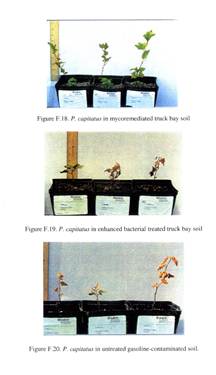

|
Mycoremediation |
||
| Applicability | ||
A strand of fungi, such as Phanerochaete chrysosporium (a form of white-rot fungus) is placed on sawdust, corn cobs, straw, peanut shells, or alder chips as a base and cultivated in heat and moisture until the fungi has completely inundated the base material. This base is then buried in contaminated soils. The results: Through the use of enzymes that break up Carbon – Carbon connections and Carbon – Oxygen connections, the mycoremediation will change the soil significantly. The soil will be a beneficial substrate soil for native Washington shrubs, unlike soils that were bacterially remediated or bioremediated not using fungi. The mycoremediation will decrease the toxicity of the soil, and decrease several polycyclic aromatic hydrocarbons, chlorinated aromatic hydrocarbons, dyes, nitro-aromatics, pesticides, components of degreasers and solvents, and other environmental pollutants such as benzene (a component of gasoline).
|
||
